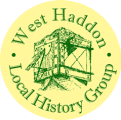The Drinking Man’s History of West Haddon.
New establishments come and go?
The end of the Red Lion left something of a vacuum in the village. About this time a tailor, Richard Turner, took out his first licence for the SPREAD EAGLE in station road, and we begin to hear of the DUN COW in West End.
An outbreak of sedition among the politically radical weavers and shoemakers in the village was challenged by an anti-sedition association headquartered at the SHEAF. The CROWN had been chosen for the Burbidge bankruptcy hearing and was also the venue for the annual Statute Fair for the hiring of servants.
Together they all slogged it out. The DUN COW disappeared on the death of its owner Richard Baucutt. (This may, or may not have had anything to do with the fact that widow Baucutt was John West’s sister.) The SPREAD EAGLE continued, never becoming more than a small ale-house. THE BELL, probably set up after the 1830 Beerhouse Act failed to survive the growth of the Temperance movement, combined with its location between the Wesleyan and Baptist chapels.
For the first half of the nineteenth century both The Sheaf and The Crown thrived, The Sheaf having been bought up by a Northampton brewer by 1840. The village population increased. It was over a thousand in 1841. Accommodation for travellers was short. John West (a cousin of the Crown’s John West) a wheelwright, began to take in lodgers. His business did well, he was able to do away with his old fashioned thatched roof, raising the house walls to their full three storeys, and inserting a date stone to commemorate the improvement in 1862. You can still see it on the wall of the old COMPASS in Guilsborough Road.
Meanwhile graziers were raising ever more livestock for the growing London market. Welsh drovers were herding cattle through the village and often needed somewhere to sleep overnight and rest their animals. A farmhouse on the edge of the village with an adjoining paddock became the GRAZIERS ARMS.
Villagers who preferred to drink at home (or wished others to believe they did not drink at all ), sent out to one of the “jug and bottles” for their supplies. There was one off-licence in Station Road, and another in West End and the shop we now know as “Paul Hopwell Antiques” was bought in 1900 by Manning of Northampton and run as a licensed grocers.
One by one the village pubs ceased to be run by self-sufficient brewing victuallers, and were sold to the growing commercial Breweries of Northampton (except for the SPREAD EAGLE which was bought in 1875 by Long Buckby Brewery) the SHEAF went to Thomas Haggar of the Northampton Brewery Company in 1838, the CROWN to Phipps in 1879, while the GRAZIERS ARMS went to the Northampton Brewery in 1855 and then to Phipps in 1959. THE COMPASS ? …We don’t know.
